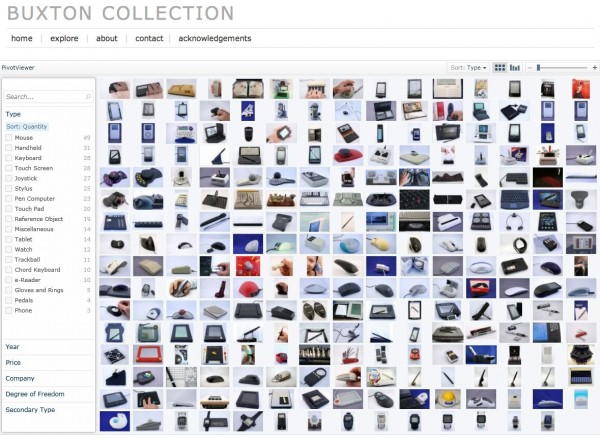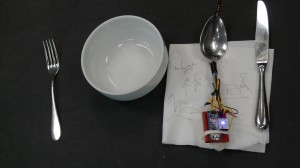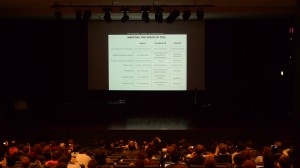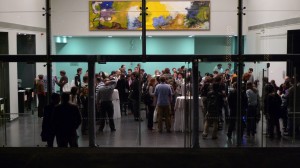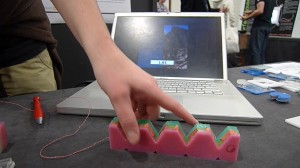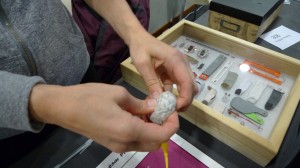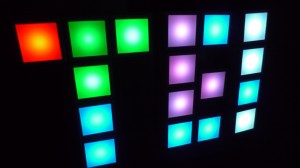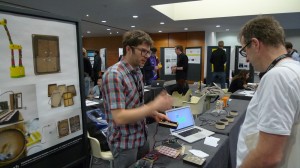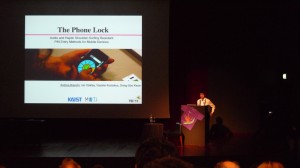Bits and pieces of May 2011
The Buxton collection of input and interactive devices
Bill Buxton exhibited at CHI 2011 in Vancouver parts of its personal input and interactive devices he has been collecting for years. A website is now available to browse the collection: Buxton Collection
Air-expelling keys for tactile sensation, patent by Apple
A recent patent application submitted by Apple proposed a pneumatic system that shoots air to provide tactile feedback of keys. I guess there are many technical challenges to overcome to deploy this commercially, but nevertheless it’s one way to give tiny localized tactile feedback without contact.
Interactive Generator: A Self-Powered Haptic Feedback Device
An evolution of the Peppermill project by MSR. In collaboration with folks from University of Washington and Phillips Exeter Academy, MSR Cambridge researchers Nic Villar and Steve Hodges presented a remote control that offers haptic feedback and is self-powered. Power generation and feedback is acheived by closely monitoring and controlling a standard servo motor. Clever! Presented at CHI 2011 in Vancouver. PDF
Enhancing Physicality in Touch Interaction with Programmable Friction
Vincent Levesque and Karon McLean from UBC got a Best Paper award for their programmable friction device I discovered earlier this Spring during my visit. The current implementation is noisy, but it works impressively well. Presented at CHI 2011 in Vancouver. PDF
Sensor Synaesthesia: Touch in Motion, and Motion in Touch
We explore techniques for hand-held devices that leverage the multimodal combination of touch and motion. Hybrid touch + motion gestures exhibit interaction properties that combine the strengths of multi-touch with those of motion-sensing. Presented at CHI 2011 in Vancouver. video
Bits and pieces of March 2011
McSig, writing with feeling
Stephen Brewster from Glasgow University, article
Haptic system based on Omni Phantom to help blind or visually impaired children to learn how to write clearly and consistently. The system is “allowing the student to feel the movements and learn the letter shapes.”
Meet Microsoft’s guru of ‘design matters’
The Seattle Times, link
A profile piece for Bill Buxton from MSR and his push for design at Microsoft. Funny that this picture was taken just outside my office space!
What Products Use Haptics?
Immersion, link
A list of products using haptics from Immersion. This is quite a narrow list, but nevertheless it presents well the large spectrum of devices and systems where haptics is valuable. Also, Immersion’s MOTIV platform is now available for Android. This quick review covers the important points (I think).
Article published in ACM’s interactions magazine
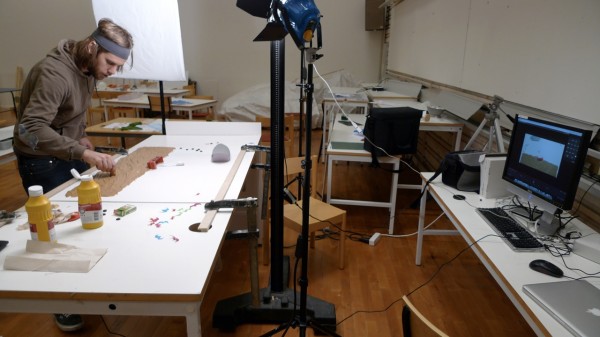
My supervisor Daniel Fallman and I wrote an article last Fall on Sketching with Stop Motion Animation. It is now published in the latest issue of interaction, the IxD magazine from ACM.
We wrote this article to convey the idea that stop motion animation is not only a great presentation style or technique, but also a great sketching process that we feel especially relevant to Interaction Design activities. It imposes you to really think about what you are doing while you are doing it. Sure, the better you plan your work and clarify your vision, the better you are off while in production mode. But approaching Stop Motion Animation like sketching with the world physical and made-up worlds opens up many other ways to evolve IxD work. You can fake movement, remix and scale time, depict interfaces mixing humans and bits in various styles and quality levels, the possibilities are pretty much endless.
Anyway, if you are interested, you can read the article online or download the March/April 2011 issue in PDF format. The article is titled Sketching with Stop Motion Animation and can be found on page 57.
Bits and pieces of February 2011
Giffi, by Kuan-Ju Wu .
Giffi is a toolkit to explore moving objects and build simple robots or kinetic stuff. It has active and passive parts for building interesting objects. The actuators cover linear, rotation and sweep movements.It has also come tangible control sliders. From CMU.
Cymatics, by Opiumble + ZIZIZIC.
Cymatics, the study of visible sound and vibration, a subset of modal phenomena. Evan Grant gave a TED talk about cymatics in 2009. Via triangulationblog.com
An impressive kinetic sculpture that ties a tie knot, by Seth Goldstein
I remembered his exhibition at MIT museum some years ago, but this one is quite an elaborate build!
Immersion’s MOTIV Haptic Development Platform
I find it interesting how they use graphics to communicate the haptic feedback qualities or signal. Worth remembering for my PhD. The sequences of users enjoying the haptic is too much. Yeap it’s the best !!! I can feel it !!! This is cool !!! It’s over the board if you ask me.
MOTIV page, demos.
A few new people I met at TEI 2011 who are working in the same domain as I do:
Seung-Chan Kim and Andrea Bianchi, both from KAIST in Korea. Petra Sundström from SICS in Stockholm.
TEI 2011
The fifth Tangible, Embedded and Embodied Interaction (TEI 2011) conference is now over and I enjoyed every bit of it. The event was hosted in a fancy hotel on the coast of Madeira in Portugal. This was my first active participation in TEI after just attending the first three editions as a plain attendee. This year, I presented my paper with Richard Banks (MSR Cambridge) as a demo, plus I was part of the student volunteers.
I arrived Saturday after a long journey from Seattle. I met with Benjamin Lopez (IxD2) at the hotel, then had a nice dinner with the other student volunteers. The conference opened on Sunday with various workshops and studios. Benjamin and I took part in the Napkin Schematics workshop organized by Nathan Seidle, founder of Sparkfun. By mid-afternoon our group had a semi working interactive spoon that displays different color depending on the temperature of the food. It was a bit silly, but most importantly we had fun building it, and I had some nice discussions with my group partners. I spent a good part of the day running around helping the organizers and workshop leaders to get their things running. There is a clear pattern in the requirements for running a conference workshop, or any workshop: you need people, a projector, power outlets and some pen and paper. But it is easier said than done. Getting hold of tens of projectors is no easy task!
On Monday morning, Gillian Crampton Smith gave a nice keynote titled Bounce Back. She presented some reflections on why aren’t tangible, embedded and embodied interfaces out there in our everyday world? Some key elements that I liked from her presentation are that physical output is hard to do right, TEI have to make sense to the users (motivation beyond new/cool), and physical outputs require an attention to details that is not generally present at the moment in IxD. Details, details, details! She supported her points with a few nice movies. The main ones were Jaques Tati – Mon Oncle and L’età del fuoco – The age of fire. She also referred to a few examples from student projects at her school in Venice.
The day continued with numerous talks and presentations in a single track format. As always some contributions are really interesting, others are less satisfying to listen to. Just before dinner, about ten teams presented their Superhero interactive costumes. It was quite fun to watch the performances and all the hiccups associated with wearables, bluetooth and battery-powered projects. It was a lovely initiative and I hope it continues in future editions of the conference.
After dinner, I went and setup my demo in the main hall. I spent a few hours making sure all my stuff was working adequately. I brought some parts to add PS2 mouse control to a particular unit, but I totally forgot to bring a PS2 mouse (the old model). Thankfully I found one at the hotel and made the swap with the newest model I had with me. At 1h30am, everything was running as I wanted, and my poster was up, so I went to bed relieved and happy.
Tuesday after lunch, an industry panel discussed a few topics around TEIs, the job market and some business outlook for tangible activities. It was motivating to hear that the demand is strong for people with the mix of hardware, software and design skills that usually characterizes TEI. The exact profile or name is not defined yet, but there is definitely a need for it (tangible prototyper, tangibler, tangible designer, etc) . After the panel, everyone moved to the demo session. I rushed to my stand and stayed there for the next 4 hours. It was quite tiring to repeat the same 1 minute elevator pitch presentation over and over, but it also allowed me to meet and share my work with many interesting people. The majority of people seemed to understand what I was trying to achieve with my work. I guess that’s a good sign. Overall, I received very good feedback and established good contacts with people who work in that same domain. My only regret is not having any time to visit and try out the other demos. I missed very interesting works I think. Next time I present my demos, I have to take a bit of time to check the other kiosks.
Wednesday, the talks were a bit more design-oriented, so more in line with my interests. Some notable presentations that I enjoyed were Andrea Bianchi’s haptic authentication system, the Designing Soft Silicone work from Ronit Slyper, and MSRC’s Rudiments presented by Alex Taylor. The conference ended with a panel with Bill Verplank, Donald Norman, Justine Cassell and Norbert Streitz. I found that the panel members were discussing issues we are mostly familiar about. I expected more thought provoking or stimulating reflections, but it was nice to notice some fundamental divergence from Don, Justine and Norbert.
In the end, it was a really enjoyable event. It was nice to meet familiar faces again, and chat with new people from everywhere around the world. This community has many engaging individuals that are so humble about their work. TEI is a very friendly, refreshing, stimulating conference series. Next year TEI 2012 will be happening in Kingston, Canada, not the most exciting location, but it is close to home!
I am staying in Madeira for a few more days, to go hiking and discover the island a bit. Let’s hope the weather is better for the coming days. See more photos on my TEI 2011 and Madeira 2011 Flickr sets. Thanks to Benjamin Lopez for the help and documentation of the demo session.
MSR Redmond
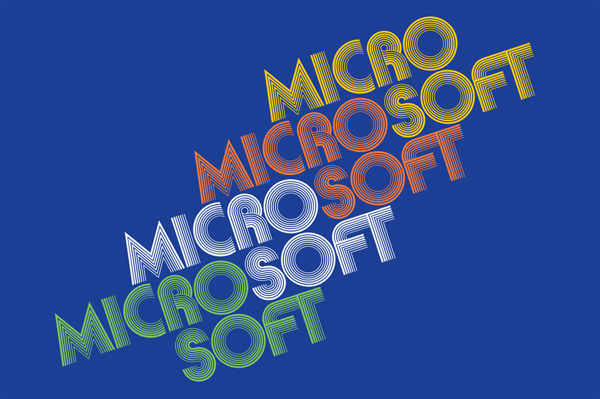
I’m now in Redmond, Washington (USA) for a few months working with the great folks at Microsoft Research (MSR). This is my second research internship with MSR and I’m now joining the Computational User Experience (CUE), working closely with Asta Roseway, Dan Morris and Desney Tan. It is all very exciting and I’m super happy to work with them for this internship. The facility is amazing, and the whole Microsoft campus in Redmond is huge. I expected a large campus, but I didn’t expect a local bike shop and a private/public transportation service.
The city of Redmond is know as “the bicycle capital of the Northwest” (wikipedia) and that fits me pretty well. There are a lot cars and highways around, but I’m impressed by the amount of cycling infrastructure the area has. There is a velodrome just 1km from where I live, but unfortunately it’s an outdoor therefore not actively used during the rainy winter season. Oh well, there are plenty of gravel trails and paved shoulders to keep my legs spinning. I decided to not live in Seattle to avoid the long daily commute to Microsoft. The bridge connecting Seattle and Redmond is not accessible by bike. I choose to live in Redmond with my friend Chao who also works at Microsoft. The bike ride to work takes 20-25 minutes in the morning with a long ascent. The return journey is much quicker as it’s all downhill minus a few sections and road crossings. It rains a lot so the full rain kit is mandatory, but I much prefer to be soaking wet and cold than stuck in traffic. I’m quite happy to be able to commute to work on a daily basis. I realized over the years that this is important to me.
I’m off to Madeira (Portugal) this Friday for TEI’11. I’m presenting my paper and demos from the work I did at MSR Cambridge last Spring with Richard Banks. It will be quite fun so catch up with a few friends and colleagues on this island off the coast of Morocco. I hope to do a bit of hiking too after the conference.
Bits and pieces of December 2010
Bits and pieces of November 2010
AAC Acoustic Technologies
http://www.aacacoustic.com
I recently had a meeting with them in Stockholm. One of the largest acoustic and haptic components provider for mobile devices. I hope to discover more about their components and solutions.
Haptics Chrome
https://github.com/mohamedmansour/haptics-chrome-extension
This Google Chrome extension adds haptics support to Google Chrome. Allows the web to send touch events to the device so that the user can feel what is happening.
SmartCall and SkinDisplay
via Core77
RIM + RCA + Vitamins Design proposing a skin display to alert and communicate personal messages to the user in less binary and disruptive ways. It reminds me of my old BA project Puce.
Reflective Haptics, by Fabian Hemmert
http://www.fabianhemmert.com/projects/reflective-haptics
Frictional actuation for haptic feedback with pen stylus. Video available. Nice idea but I wonder how much haptic qualities is lost by using a actuated ball on the tip of the pen. It sure adds some possibilities for feedback, but I guess we loose a bit too. Fabian also gave a talk at TEDxSalzburg earlier this month about less-disruptive mobile phones.
ImpAct: Immersive Haptic Stylus
Demoed at UIST 2010
ImpAct is a stylus which can dynamically change its effective length and it is equipped with sensors to calculate its orientation in world coordinates. Video available.
Axsotic’s 3D-Spheric-Mouse
http://gizmodo.com/5681524/is-this-the-mouse-of-the-future
da Vinci robots perform first all-robot surgery McGill University
http://www.engadget.com/2010/10/21/first-all-robot-surgery-performed-at-mcgill-university/
I don’t like haptic arm-type devices, but sure they are useful for minimally invasive surgery. It’s better than having to open up bodies. I wonder how good/hard is the feedback on the da Vincis robots.
Sketching Haptics Workshop at Chalmers in Gothenburg
I’m in Gothenburg for a few days, to conduct a small workshop with the Masters Students from Chalmers University, part of the The Augmented Body course (blog) organized by Johan Sandsjö.
I’ll post photos and a review of the activities very soon. In the meantime, I am publishing PDF version of the presentations I made during my visit. The visual quality of the projection was very weak, sorry for that. I should have tested it beforehand, I know.
Tuesday Nov. 9 2010
Presentations: Introduction.camille.pdf, Prototyping.levels.pdf
Wednesday Nov. 10 / Thursday Nov. 11 2010
Simple Haptics presentation: Research.talk.moussette.pdf
TEI paper accepted!
Yippi, my submission to TEI’11 (Tangible, Embedded and Embodied Interaction) conference was accepted. The reviews contain good feedback, and they highlight some weaknesses that were totally known to me. I wrote this submission just before leaving for my sea kayaking in Greenland this summer. I was busy in Paris, getting ready for my trip, but I nevertheless decided to dedicate 24 hours to write something from my recent MSRC work. It was a sleepless night, and I was totally exhausted when I jumped on the plane toward Iceland.
The current title is Designing through Making: exploring the simple haptic design space. I have revisions to do during the coming weeks, let’s see if I keep this title or not.
The conference is in Madeira (Portugal) next January: http://www.tei-conf.org/11

